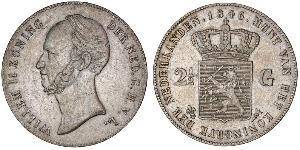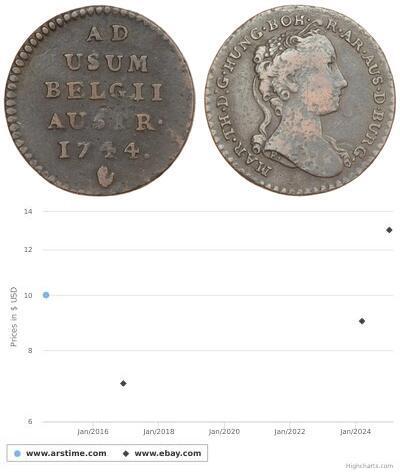1 Ducat Kingdom of the Netherlands (1815 - ) Gold
1831, Netherlands (Kingdom), William I. Gold Knight Ducat Coin
Mint Year: 1831
Denomination: Gold Knight Ducat
State: Kingdom of the Netherlands
Mint Place: Utrecht (privy mark: torch)
Reference: Friedberg 331, KM-50.1.
Diameter: 21mm
Weight: 3.46gm
Material: Gold!
Obverse: Knight standing right in armour, holding sword which rests on shoulder and a bundle of arrows, splitting date (18-31).
Legend: CONCORDIA . RES PAR . CRES . TRA . (torch – caduceus)
Expanded: “CONCORDIA RES PARvae CREScunt TRAjectum”
Translated: "Through unity little things grow (Union is strength), Utrecht."
Reverse: Legend in five lines inside ornate square. Fields around decorated with floral ornaments.
Legend: MO ORDI PROVIN FOEDER BELG AD LEG IMP
Expanded: “MOneta ORDinum PROVINciarum FOEDERatorum BELGicarum AD LEGem IMPerii”
Translated: "Coin of government of the provincial federation of Belgium Conforming with the law of the Imperial."
Minted in Holland beginning in the 17th century to fuel its extraordinary tenure as the world’s foremost commercial trader, the Netherlands one ducat gold coin offers both strong visual appeal and a scarcity value that could command a healthy premium in the years to come. The first Netherlands trade ducat was issued in 1487 under Phillip the Fair and a coin very similar to the one depicted above has been minted more or less continuously from the early 1600s on. The net fine weight of 3.5 grams gold never changed to the modern era. The trade ducat is minted as a gold bullion coin even today. Only the Venetian ducat has enjoyed greater longevity. The obverse of the famed ducat coin depicts a knight holding a bundle of arrows signifying the unity of the six northern provinces under the 1579 Union of Utrecht — a declaration of independence from Spain. The motto Concordia Res Parvae Crescunt translates to “the union makes small things grow.” The legend on the reverse translates to "money of the provinces of the United Netherlands according to the law of the empire."
The Kingdom of the Netherlands (Dutch: Koninkrijk der Nederlanden, commonly known as simply the Netherlands, consists of the entire area in which the monarch of the Netherlands functions as head of state. The realm is not a federation; it is a collection of states and territories united under its monarch. 98% of its territory and population is in Western Europe; it also includes several small West Indian island territories in the Caribbean (in the Leeward Islands and Leeward Antilles groups).
The Kingdom of the Netherlands originated in the aftermath of French Emperor Napoleon I’s defeat in 1815. In that year the Netherlands regained its independence from France under its First French Empire, which had annexed its northern neighbour in 1810, as the Sovereign Principality of the United Netherlands. The great powers of Europe, united against Napoleonic France, had decided in the secret treaty of the London Protocol to establish a single state in the territories that were previously the Dutch Republic/Batavian Republic/Kingdom of Holland, the Austrian Netherlands and the Prince-Bishopric of Liège, awarding rule over this to William, Prince of Orange and Nassau, although the southern territories remained under Prussian (German) rule until Napoleon’s return from his first exile on Elba (“Hundred Days”).
In March 1815, amidst the turmoil of the Hundred Days, the Sovereign Prince William of Orange and Nassau adopted the style of “King of the Netherlands”. Following Napoleon’s second defeat at the Battle of Waterloo in June 1815, the Vienna Congress supplied international recognition of William’s unilateral move. The new King of the Netherlands was also made Grand Duke of Luxembourg, a part of the Kingdom that was, at the same time, a member state of the German Confederation.
(740 X 370 pixels, file size: ~57K)
Posted by: anonymous 2020-11-16
1818,Niederlande-Königreich. Wilhelm I. 1815-1840. Dukat 1818, Utrecht. K.M. 50.1, Friedberg 331. GOLD. Winzige Kratzer, sehr schön - vorzüglich.
(740 X 368 pixels, file size: ~58K)
Posted by: anonymous 2020-11-25
1830,Niederlande-Königreich. Wilhelm I. 1815-1840. Dukat 1830, Utrecht. K.M. 50.1, Friedberg 331, Delmonte 1188. GOLD. Sehr schön - vorzüglich.
(1500 X 748 pixels, file size: ~179K)
Posted by: anonymous 2019-03-24
Niederlande-Königreich. Wilhelm I. 1815-1840. Dukat 1831. Friedberg 331, Schulman 215. GOLD. Vorzüglich
(1500 X 744 pixels, file size: ~180K)
Posted by: anonymous 2019-03-24
Niederlande-Königreich. Wilhelm I. 1815-1840. Dukat 1836. Friedberg 331, Schulman 220. GOLD. Winzige Kratzer, vorzüglich
(1500 X 756 pixels, file size: ~189K)
Posted by: anonymous 2018-03-30
Niederlande-Königreich. Wilhelm I. 1815-1840. Dukat 1817, Utrecht. Friedberg 331. Besserer JahrgangGOLD. Winzige Kratzer, vorzüglich
(740 X 370 pixels, file size: ~54K)
Posted by: anonymous 2019-05-29
1839,NIEDERLANDE. Königreich der Niederlande. Wilhelm I. 1813-1840. Dukat 1839, Utrecht. 3.51 g. Schulman 223. Fr. 331. Vorzüglich / Extremely fine. (~€ 220/USD 250)

-500-250-S5IKbzbiDHkAAAFLS6rk0KRZ.jpg)
-300-150-yUx_dbXU3bQAAAF1dA_iU874.jpg)
-300-150-1GOM7svHrmYAAAF231OUxgEy.jpg)
-300-150-_13ZGYbccdAAAAFp7iiZt65E.jpg)
-300-150-OdzZGYbcLIgAAAFpH7aZt7GA.jpg)
-300-150-qIsKqUpYMyEAAAFim5ys73jU.jpg)
-300-150-qp0bmpJTrhMAAAFrv3ghfwXz.jpg)













